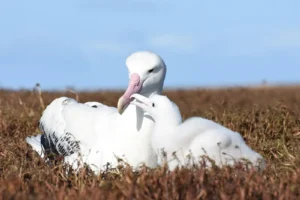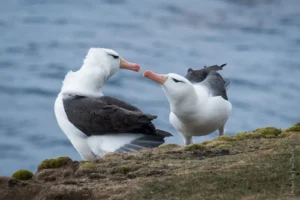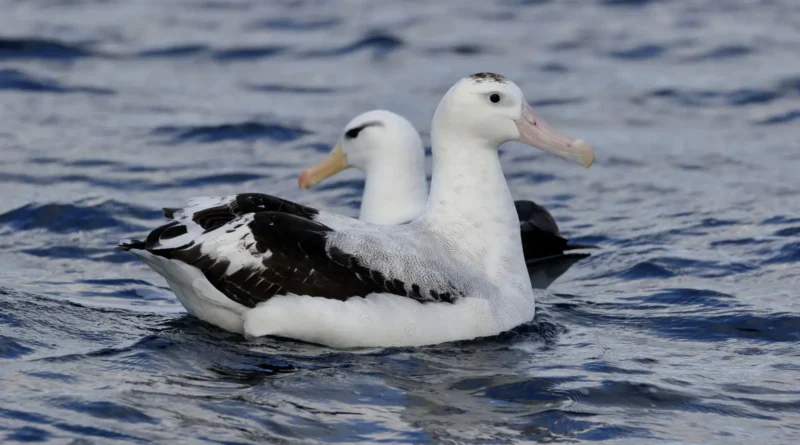The Longevity of Albatross Relationships
Albatrosses, with their impressive wingspans and graceful flights over the open ocean, are not only symbols of freedom but also exemplars of enduring relationships in the avian world. These seabirds, belonging to the family Diomedeidae, are renowned for their monogamous pairings that often span decades, providing a captivating insight into avian social dynamics and the complexities of life at sea.
Introduction: The Albatross Connection
Albatrosses spend the majority of their lives in flight over vast expanses of ocean, traversing thousands of miles in search of food and suitable nesting sites. Despite their solitary existence at sea, they exhibit complex social behaviors, including the formation of lifelong pair bonds that endure across time and distance.
Albatross Monogamy and Lifelong Bonds
One of the most remarkable aspects of albatross relationships is their strong inclination towards monogamy. Once a pair forms, it typically remains intact for multiple breeding seasons and, in many cases, for the entirety of their lives. This fidelity is particularly noteworthy given the challenges posed by life on the open ocean, where individuals may spend extended periods away from their breeding sites.
The formation of lifelong bonds begins with elaborate courtship rituals, where prospective mates engage in intricate displays of dance, vocalizations, and mutual preening. These rituals not only serve to attract a partner but also establish a strong foundation for a committed relationship. Once paired, albatrosses collaborate on critical tasks such as nest building, egg incubation, and chick rearing, solidifying their bond through shared responsibilities and mutual support.
Navigating Long-Distance Relationships

Albatrosses are renowned for their extensive foraging ranges, which can span thousands of miles across the oceans. During the non-breeding season, individuals may spend months apart from their partners, navigating the vast expanse of the open sea. Despite these separations, albatross pairs demonstrate remarkable fidelity, often returning to the same nesting site and reuniting with their mates year after year.
The ability of albatrosses to maintain their relationships over long distances underscores the strength of their pair bonds. While at sea, these birds likely rely on a combination of visual cues, celestial navigation, and olfactory senses to locate their breeding sites and reunite with their partners. This navigational prowess ensures that individuals can find each other amidst the expansive and often featureless ocean.
Challenges of the Breeding Season
The breeding season presents a different set of challenges for albatross pairs as they work together to raise their young. These birds invest significant time and energy in nesting activities, with both parents sharing responsibilities such as incubation shifts and provisioning food for their chicks. This cooperative effort not only enhances breeding success but also strengthens the bond between partners.
Despite the demanding nature of breeding, albatross pairs demonstrate remarkable coordination and cooperation. Successful reproduction relies on the ability of both partners to synchronize their efforts, from nest building to chick rearing, showcasing the importance of mutual support and collaboration in ensuring the survival of their offspring.
Factors Contributing to Relationship Longevity
Several factors contribute to the longevity of albatross relationships. Mutual reliance, reinforced by shared responsibilities during breeding, fosters a sense of partnership and cooperation between mates. Additionally, the selective nature of courtship rituals, where individuals choose mates based on compatibility and suitability, helps to maintain stable pair bonds over time.
Furthermore, the extensive investment in raising offspring underscores the importance of parental cooperation and coordination. Albatrosses that successfully rear chicks together are more likely to reinforce their pair bond and continue their relationship into subsequent breeding seasons.
Environmental Challenges and Adaptations

Albatrosses face numerous environmental challenges, including habitat loss, climate change, and overfishing, which can impact their breeding success and overall population dynamics. Despite these challenges, albatross pairs demonstrate remarkable resilience, adapting their behaviors and strategies to navigate the changing conditions of their oceanic habitats.
Conservation Efforts and Future Outlook
Efforts to conserve albatross populations are underway, focusing on mitigating threats such as bycatch in fishing gear, habitat degradation, and invasive species predation. Conservation measures include the establishment of protected marine areas, the development of sustainable fishing practices, and public awareness campaigns to promote responsible stewardship of ocean resources.
The future outlook for albatrosses and their enduring relationships depends on concerted conservation efforts and a commitment to preserving their habitats and ecosystems. By safeguarding these magnificent seabirds and their unique social behaviors, we can ensure that future generations continue to marvel at the beauty and resilience of albatross relationships in the vast expanse of the open ocean.
Conclusion: A Testament to Enduring Commitment
In conclusion, the longevity of relationships among albatrosses is a testament to the enduring commitment and cooperative nature of these remarkable seabirds. Through elaborate courtship rituals, shared nesting duties, and mutual reliance during the challenges of life at sea, albatross pairs exemplify the strength and resilience of lifelong partnerships in the natural world. Studying the dynamics of albatross relationships not only provides insights into avian behavior but also underscores the universal value of commitment and cooperation in fostering enduring bonds amidst the vastness of the ocean.
As we continue to explore and conserve the habitats of these magnificent birds, we gain a deeper appreciation for the intricate connections that bind them together and sustain their relationships across the ever-changing seascape. Albatrosses serve as ambassadors of enduring love and partnership, inspiring us to cherish and protect the natural world and the remarkable creatures that inhabit it.

